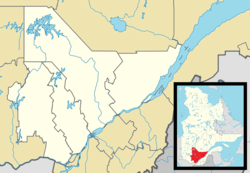Gore is a township municipality in the Canadian province of Quebec, located within the Argenteuil Regional County Municipality. Its main community is Lakefield.[citation needed]
Gore | |
|---|---|
 | |
 Location within Argenteuil RCM | |
| Coordinates: 45°46′N 74°15′W / 45.77°N 74.25°W[1] | |
| Country | Canada |
| Province | Quebec |
| Region | Laurentides |
| RCM | Argenteuil |
| Settled | 1840s |
| Constituted | July 1, 1855 |
| Named for | Francis Gore[1] |
| Government | |
| • Mayor | Scott Pearce |
| • Federal riding | Argenteuil—Papineau—Mirabel |
| • Prov. riding | Argenteuil |
| Area | |
| • Total | 96.45 km2 (37.24 sq mi) |
| • Land | 90.04 km2 (34.76 sq mi) |
| Population (2021)[3] | |
| • Total | 2,283 |
| • Density | 25.4/km2 (66/sq mi) |
| • Pop 2016-2021 | |
| • Dwellings | 1,615 |
| Time zone | UTC−5 (EST) |
| • Summer (DST) | UTC−4 (EDT) |
| Postal code(s) | |
| Area code(s) | 450 and 579 |
| Highways | |
| Website | www |
Geography
Located in the Laurentian Mountains, the township consists of rugged Canadian Shield with an elevation varying between 168 meters (551 ft) and 427 meters (1,401 ft). The terrain is characterized by forested mountains and numerous streams and lakes. Notable lakes include Barron, Hughes, Chevreuil, aux Oiseaux, Solar, Caroline, Evans, Dawson, Clark, Grace, Sugarloaf, Clair, and Carruthers; many of them have been entirely developed over the years, but there still remain many with little or no construction to date.[4]
The majority of its territory is covered by old-growth forests with a wide variety of species both deciduous and coniferous, such as birch, poplar, sugar maple, beech, white pine, fir, spruce, hemlock, and cedar.[4]
History
The Gore Township was established in 1840, named after Francis Gore (1769–1852), Lieutenant-Governor of Upper Canada from 1806 to 1811 and from 1815 to 1817. It was colonized by Scottish and Irish settlers, such as Robert Smith and James Stephenson.[1][5]
In 1845, the Gore Municipality was formed, abolished two years later, and restored in 1855. In 1853 it had about 1000 inhabitants but this dropped to about 800 people ten years later, almost all of Irish origin. The Gore Post Office operated between 1898 and 1958.[1]
Demographics
| Year | Pop. | ±% |
|---|---|---|
| 1976 | 410 | — |
| 1981 | 576 | +40.5% |
| 1986 | 706 | +22.6% |
| 1991 | 982 | +39.1% |
| 1996 | 1,133 | +15.4% |
| 2001 | 1,260 | +11.2% |
| 2006 | 1,540 | +22.2% |
| 2011 | 1,775 | +15.3% |
| 2016 | 1,904 | +7.3% |
| 2021 | 2,283 | +19.9% |
| Source: Statistics Canada[6] | ||
In the 2021 Census of Population conducted by Statistics Canada, Gore had a population of 2,283 living in 1,124 of its 1,615 total private dwellings, a change of 19.9% from its 2016 population of 1,904. With a land area of 90.04 km2 (34.76 sq mi), it had a population density of 25.4/km2 (65.7/sq mi) in 2021.[7]
| 2021 | 2016 | 2011 | |
|---|---|---|---|
| Population | 2,283 (+19.9% from 2016) | 1,904 (+7.3% from 2011) | 1,775 (+15.3% from 2006) |
| Land area | 90.04 km2 (34.76 sq mi) | 92.68 km2 (35.78 sq mi) | 92.91 km2 (35.87 sq mi) |
| Population density | 25.4/km2 (66/sq mi) | 20.5/km2 (53/sq mi) | 19.1/km2 (49/sq mi) |
| Median age | 54.8 (M: 54.8, F: 54.0) | 52.6 (M: 52.6, F: 52.7) | 49.3 (M: 49.1, F: 49.6) |
| Private dwellings | 1,615 (total) 1,124 (occupied) | 1,542 (total) | 1,495 (total) |
| Median household income | $73,000 | $61,184 | $56,887 |
Mother tongue (2021):
- English as first language: 17.8%
- French as first language: 76.8%
- English and French as first language: 2.2%
- Other as first language: 3.1%
Local government

| Year | Liberal | Conservative | Bloc Québécois | New Democratic | Green | ||||||
|---|---|---|---|---|---|---|---|---|---|---|---|
| 2021 | 35% | 337 | 14% | 130 | 36% | 341 | 7% | 70 | 0% | 0 | |
| 2019 | 32% | 305 | 11% | 103 | 42% | 405 | 8% | 75 | 5% | 52 | |
| Year | CAQ | Liberal | QC solidaire | Parti Québécois | |||||
|---|---|---|---|---|---|---|---|---|---|
| 2018 | 39% | 391 | 22% | 219 | 14% | 138 | 17% | 169 | |
| 2014 | 22% | 215 | 40% | 384 | 4% | 41 | 32% | 310 | |
Gore forms part of the federal electoral district of Argenteuil—La Petite-Nation and has been represented by Stéphane Lauzon of the Liberal Party since 2015. Provincially, Gore is part of the Argenteuil electoral district and is represented by Agnès Grondin of the Coalition Avenir Québec since 2018.
List of former mayors:
- Ron Kelley (1997–2005)
- Scott Pearce (2005–present)
Education
The Commission scolaire de la Rivière-du-Nord (CSRDN) operates Francophone public schools:[15]
- École primaire Bellefeuille in Saint-Jérôme
- École secondaire Émilien-Frenette in Saint-Jérôme and École polyvalente Lavigne in Lachute
The Sir Wilfrid Laurier School Board operates English-language public schools:
- Laurentian Elementary School in Lachute[16]
- Laurentian Regional High School in Lachute[17]
See also
References
Further reading
- "Gore, Quebec (Code 2476025) Census Profile". 2011 census. Government of Canada - Statistics Canada.
External links
 Media related to Gore, Quebec at Wikimedia Commons
Media related to Gore, Quebec at Wikimedia Commons

